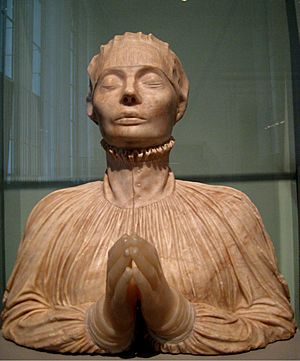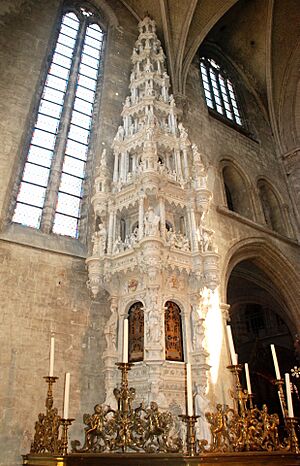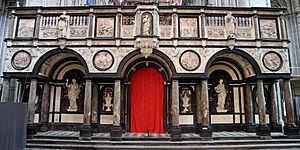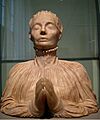Cornelis Floris de Vriendt facts for kids
Cornelis Floris (around 1514 – October 20, 1575) was a very talented artist from Flanders. He was a sculptor, an architect, and a designer of prints and fancy objects. Cornelis Floris ran a big workshop in Antwerp, a city in modern-day Belgium. From there, he worked on many large building projects in Flanders, Germany, and Denmark.
He was one of the designers of the famous Antwerp City Hall. Cornelis Floris created a new art style. It mixed Flemish traditions with the Italian renaissance style of the 1500s. His new ideas spread across Northern Europe. They greatly influenced how sculpture and architecture developed in the 16th and early 17th centuries.
Contents
Who Was Cornelis Floris?
Cornelis Floris II was born around 1514. He was the oldest of four sons. His family, originally called 'de Vriendt', had been stonemasons in Brussels for a long time. One of his ancestors became a master stonemason in Brussels in 1406.
A family member moved to Antwerp in the mid-1400s. The name 'Floris' then became the family's common last name.
Early Life and Training
We don't know much about how Cornelis Floris learned his skills. He probably worked in his father's stonemason workshop. He traveled abroad and was reportedly in Italy when his father died in 1538. After that, he returned to Antwerp to help his mother and younger brothers.
In 1539, he became a master in the local Guild of Saint Luke. This was an important group for artists. He was even the leader (dean) of the Guild in 1547 and 1559. Around 1540, Cornelis decorated the guild's register with special 'grotesque' designs. These designs were inspired by old Roman art found in Italy. These 'grotesque' patterns became a key part of his unique style.
In 1550, Floris married Elisabeth Machiels. He bought a house in Antwerp and rebuilt it in his own artistic style.
Floris's Artistic Family
Cornelis Floris II died on October 20, 1575. When he started his career, the Renaissance art style was just beginning in the Netherlands. By the time he died, this new style was very popular. Artists like Floris didn't just copy the Italian style. They added their own local touch to it.
Cornelis's brothers also became great artists. His most famous brother was Frans. Frans was a leading Flemish mannerist painter. Jacob was a painter of stained-glass windows, and Jan was a potter.
Cornelis Floris had many students. Several of them became famous artists themselves. These included Willem van den Blocke and Gert van Egen.
What Did Cornelis Floris Create?
Cornelis Floris was an artist who could do many things. He worked mostly as an architect and sculptor. But he also designed prints and other items like vases.
Sculpture and Monuments
As a sculptor, Cornelis Floris is best known for his work on funeral monuments. In 1549, he received a big job to create a monument for Dorothea. She was the wife of a duke and the daughter of the Danish king. This monument was placed in Königsberg Cathedral.
This was the start of many jobs for royal family tombs in Denmark. He designed the tomb of Duke Albert in Königsberg Cathedral. He also created the mausoleum for King Christian III and the monument for King Frederick I in Schleswig Cathedral. These monuments were usually made of marble, with the statue of the person made from alabaster.
In his home country, he created a stone tabernacle in 1522 for St. Leonard's Church in Zoutleeuw. This was a tall, nine-level tower, 18 meters high. It was made of white stone and shipped in pieces from Floris's workshop. This work still had some older Gothic art elements.
He made another tabernacle in a pure Renaissance style for a church in Zuurbeemde (now part of Glabbeek) between 1555 and 1557. He also made the rood screen for the Notre-Dame Cathedral in Tournai.
These large projects show that Cornelis Floris had a big workshop with many workers. He mostly organized and planned the work. His students and assistants traveled to different places, often in Northern Europe. There, they helped set up the monuments that Floris designed. Many of them stayed in these places and started their own workshops. They often continued to help with Floris's designs. Some of these artists, like Willem van den Blocke, became court artists. They helped spread Floris's style across Northern Europe.
Architecture Designs
From the late 1550s, Cornelis Floris also designed buildings. He is listed as one of the architects for the Antwerp City Hall. Many architects and sculptors worked together on this building. Cornelis Floris played a very important role in its design and construction. He even visited stone quarries to pick out the best stone. His large workshop in Antwerp had many assistants who worked on the city hall project. They likely focused on the sculptures for the inside and outside of the building.
The Antwerp City Hall became a symbol of the new Renaissance style in the Netherlands. Other city halls, like those in Vlissingen and The Hague, were inspired by it. The design of the city hall in Emden, Germany, and the Green Gate in Gdańsk, Poland, also show his influence.
Cornelis Floris also designed the Hanseatic League building in Antwerp and his brother Frans's town house. Sadly, these buildings no longer exist.
Graphic Art and Prints
Floris was a busy designer of prints. He worked with publishers in Antwerp on many projects. For example, in 1648, a series of 21 prints called Vases, jugs and bowls with grotesques was published. These showed his designs for these items with 'grotesque' patterns.
In 1555, another set of 18 prints was published. It was called Ingenious depiction of various forms of masks. These prints showed 'grotesque' designs based on old Roman art. The 'grotesque' style came from ancient Roman designs found in underground rooms in Rome. These designs often used shapes from fish, animals, or plants. Floris is known for creating a Flemish version of this style around 1541.
These publications helped spread Floris's new ideas and style all over Northern Europe.
Images for kids
See also
 In Spanish: Cornelis Floris de Vriendt para niños
In Spanish: Cornelis Floris de Vriendt para niños











